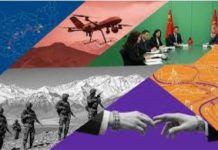Syed Laique Haider
In politics among Nations, Hans J. Morgenthau contends that “International politics, like all politics, is a struggle for power”. A reality that remains undiminished in 21st Century that power is the central principle of Global Politicsand persists to govern state behavior.
From Ancient Empires to Modern Nation States, the dominant logic of International Relations has consistently prioritized competition over cooperation. Thucydides, a firsthand observer of Peloponnesian war argues that, “The strong do what they can and the weak suffer what they must”. He furtherelaboratesthat the rising power of Athens disrupt Sparta, inciting a devastating conflict that ended in Athenian defeat and proved that fear and power shape the destiny of states. Through another lens, Treaty of Westphalia (1618-1648) marked the turning point in global politics builtupon the principle of Modern Nation State. It established the earliest boundaries of Sovereignty, endorsed states to make decisions unilaterally in their national Interest. That was the transition that built the essence of Realism, where national Interest, borders and power determined the grammar of global politics.
World War-I & II exposed the failure of idealism as power led to war by forming blocks like Triple Entente and Axis power to secure National Interest and led to emergence of Realism. In the era of indirect warfare, the Cold Warsegregatedthe world into adversarial ideological blocs, as the USA and USSR confronted through proxy wars, nuclear deterrence, and global power chess.The conflicts etched a truth in global world order and proved that balance of power and harsh realism of nuclear deterrence could ensure state survival in an anarchic world.
In the complex chessboard of International Relations, strategic considerations often eclipse the moral judgments, the strategic contest between United State and China hasestablished the core struggle of this era.John Mearsheimer, a prominent Realist theorist argues that “The United States will go to great lengths to contain China and maintain its regional hegemony in Asia”.The Indo-Pacific region has become a strategic conflict zone where hegemony defines power.
In an era where power determined security, AUKUS has turned into strategic pillar of Realist geopolitical contest between U.S and China. A trilateral pact amongU.S, UK and Australia have illustrated the Realist logic of hard balancing, empowering Australia to possess nuclear powered submarines and enhanced defense power to deter China’s rise of Naval dominance in the Indo-Pacific.It exemplifies self help, deterrence and alliance building as core tactic for state security in anarchic system. Geelong Treaty (July, 2025) secured a 50 year UK-Australia submarine pact, unveiling a strategic move to counter China amid strategic flux of U.S priorities.
QUAD aligning US, Australia, Japan and India, has transformed soft Realism structure to counter China’s rise in Indo-Pacific. Despite lacking formal strategic framework like AUKUS, it strengthens intelligence sharing, maritime collaboration and organized military drills to resist China’s dominance devoid of full scale warfare. In June 2025, QUAD conducted its largest ever Naval exercises near to South China Sea, engaging carrier strike forces, drones and anti- submarines system as evidence of cohesive deterrence.
Amid the dynamics of Realpolitik, drills serve as strategic declarations. Now shifting through another lens, recent PLA Exercises Revealed China’s Operational Plan for a Taiwan Strait Conflict.The two-day military exercise conducted by the PLA in early April suggested a three-phase operational plan that the PLA is likely to adopt for a campaign against Taiwan. The People’s Liberation Army (PLA), China’s joint Military Force served as the critical tool of Beijing’s Hard Power. In April 2025, PLA organized”Strait Thunder – 2025/A”, a large-scale strategic exercise included demonstration of missile strikes, naval blockades and combined sea land operations near Taiwan. Through a Realist lens, such drills reflect China’s commit to deter US Alliances i.e AUKUS and QUAD by military strength and secure National Interest through force if required.
While others formed Alliances, China initiatives infrastructure as silent weapon in global power competition. China’s Belt and Road Initiatives (BRI) renewed momentum in 2025 through new infrastructure deals among global trade regions. Recently, China strengthened ties in Central Asia and Africa with major Agreements in Kazakhstan and Egypt focused on digital networks, energy and transport. In April 2025, it launched a direct shipping route from Guangzhou to Peru’s Chancay port by enhancing its influence in Latin America and lowering logistics costs.BRI is Realpolitik driven plan to enhance China’s power by constructing railways, trade corridors and ports. In anarchic system, states use every instrument of power including economic strategy to secure National Interest without entirely depending on military force.
The 20th Century proved that Realism excelled not in peace but in everlasting struggle, where proxy wars became the strategic weapon of Global Supremacy. Navigating under the veil of Nuclear Deterrence, United States and Soviet Union evaded open conflict but extended power through proxy wars including Korean War (1950-1953) where contending regimes were weaponized to secure dominance, Vietnam War (1955-1975) in which Washington Struggled to contain Communist Expansion. In Angolan Civil War (1975-2002) where both global powers endorsed opposing block in Africa and Soviet-Afghan War (1979-1989) also witnessed competitors for strategic hegemony by facilitating antagonist Afghan faction without direct conflict. Proxy wars elucidated the realist struggle of the 20th Century but today power game has turned into sixth generation warfare.
In 21st Century, modern conflicts have been switched from traditional warfare to non-kinetic warfare including cyber, propaganda, psychological and economic warfare. Realism examines these tools as strategic expansion of power in global politics. Emerging bipolarity is marked by China’s Belt and Road Initiatives, the U.S-India Strategic partnership and Russia’s Regional objective escalating competition for dominance. In South Asia, Indo-Pak relationship also remains locked in a Realist Security Dilemma. The perpetual conflict between India and Pakistan in not a diplomatic collapse, it is realist power politics where survival supersede the emotions. In the harsh arena of global politics, power, survival and strategic tactics seem to prevail throughout the globe. In 21st Century, states driven by self-interest, not ideals, act with strategy and vigilance will shape the world’s turbulent course.

















